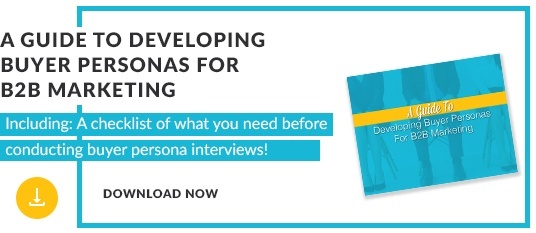 Ericka Lewis
Ericka Lewis
When B2B prospects are researching products and services, the last thing they want to do is spend one minute slogging through yet another piece of lackluster repetitive content.
What you have to remember is that your B2B audience are human too and that your content not only represents your brand, but perhaps most importantly, it can be both the barrier or the bridge to a fruitful relationship depending on how you write it.
If you want your prospects to seriously consider your products and services or trust you as an industry leader, your content should not only have depth, brevity, and usefulness, but more importantly, --- it should keep the readers' attentions, rally them into committing an action, and make a lasting and pleasant impression.
"But my industry is boring so my content is boring too..."
No. It isn't and it doesn't have to be, unless you make it to be. Don't limit your content to the mundane and overly-discussed topics of your industry. Release your inner creativity-Kraken and let loose. Write every piece of content with an intent to elicit a reaction. Add a dash of personality to every content you produce. How, you asked? Easy peasy.
Here are 10 tried-and-true tips for injecting a little personality in your boring B2B content:
1. Use an active voice.
Your high school English teacher probably spent too many days drilling this into your head, but it was for good reason. Active sentences get right to the point and keep your narrative moving along. They're not bogged down with complex arrangements, and they never leave the reader confused about who is doing what.
Observing an example is the best way to nail the active voice:
- Passive: It is believed by the client that good service must be delivered by any vendor.
- Active: The client believes that vendors must deliver good client service.
Always make sure the players (subjects) in your sentences are the ones doing the acting (verbs).
2. Be adventurous in your grammar and vocabulary.
While it's important to make sure that your spelling and grammar are proper, it's also ok to occasionally break the rules to make your content a bit more interesting and emphasize a point or an emotion. You still want to keep the tone professional, but it's ok to go a bit business-casual and use appropriate slang or change up the punctuations to make a point. Just make sure that it's clear that you're doing it intentionally or the Grammar Police will show up in the comments section.
3. Use humor.
Funny content is not only entertaining, but memorable.
In fact, a 2013 study found that 80% of college students were able to recall advertising that made them laugh.
The key to using humor is to make sure you're genuine and original (read: not lame). It's a tricky thing to master, and you're better off leaving humor out if you can't hit the mark. If you do however, know your buyer personas well, this shouldn't be a problem. Find out what makes each buyer persona tick and speak their language.
Protip: Let a couple coworkers read your content before posting it on the internet so you can be sure your joke about clowns tasting funny is still relevant.
4. Cite anecdotes and facts.
Half of all bloggers make big claims in their content that cannot be backed up with facts. Not really, of course, but you see what I did there? If you want to be taken seriously, cite any facts or statistics that you use so your readers know you've done your homework.
It's also important to cite anecdotes, especially if you're using them to make a point. Any creative writer can concoct a story, but readers will put a lot more weight on a real-life scenario. If you want to position your business as a trustworthy thought leader in the industry, you definitely have to know the integrity of what you're dishing out.
5. Write like you talk and talk as if you're talking to your peers.
Don't try to impress your readers by busting out your 25-cent words. You'll only alienate them with misunderstanding or make them think you're pompous. At the same time, don't talk down to them, either.
If you use a lot of lingo and industry jargon at work, use it in your content with the right context and a relaxed and friendly tone. It adds authenticity and helps people follow along without being distracted by your word choice. After all, if you're going for the opposite of boring, you have to forge a familiar, likeable, and engaging tone and sounding like a lawyer will not help you achieve that.
6. Be open to using puns and metaphors.
If you cannot nail the humor, maybe give puns and metaphors a try. In much the same way that humor keeps people engaged and helps them remember what you've said, puns and metaphors provide a mental break for readers and allows them a rest without disengaging from your words. Metaphors can also help you break down complex information to make it easily digestible, yet still delicious to the hungry mind.
7. Build suspense.
Building suspense is a strategy one has to practice with sophistication. When you use suspense, you give your readers a reason to keep going down to the bottom. Now, there is a fine line between strategically and tastefully building suspense versus click-baiting, and definitely stay away from the latter.
To add a bit of suspense to your content, lay the foundation for a few questions upfront, but don't get to the complete answers right away. Instead, slowly give out the information that will lead to the answer, then conclude your post with succinct statements that answer the questions.
8. Take a stand to elicit an emotional response.
This doesn't mean you should start railing a presidential candidate or take a stand on abortion just to get a response from your readers. Instead, think about what your clients care about or are struggling with, and provide a clear solution with authority. In other words, don't be wishy-washy about what you're telling your readers with words like "can," or "might." You will help solve their problems and they will be awed by your expertise.
9. Ask rhetorical questions.
Are you ready to learn how to get readers to jump right into your content with both feet? Using rhetorical questions can jump-start the reader's thought process and get them going on a positive note. Make sure you use rhetorical questions sparingly as it can be tiresome to answer a bunch of questions (as anyone with a 3-year-old can attest), and always make sure the answer to your question is a resounding super-positively energizing YES!
10. Be mindful of how you format your content.
By now, you're a brilliant writer with the ability to carry your readers all the way through your narrative while eliciting laughter and the occasional tear before they rush to click the button on your call-to-action. This doesn't mean that people are ready to settle in for a novel-like reading of huge chunks of texts and long paragraphs.
When people read content on the web, they like short paragraphs, plenty of subheadings, and lots of white space or their eyes start wandering and eventually they just give up altogether.
Bonus Tip: Read engaging and fun content to produce engaging and fun content!
It's like the "you are what you eat" adage, but with the content you consume.
Stephen King once said that to be a writer, you must read a lot.
We'll expand on that a bit and say that to write content with personality, you have to read content with personality. When you come across content that you really love, find more content from that writer or something of similar nature and keep reading. You have to be inspired yourself to be able to create an awe-inspiring content.
Take it Or Leave It
Maybe that clown joke wasn't so funny after all. But don't worry. It's not essential that everything you write be a knee-slapper. The point is B2B content need not be dry and a pain to both the writer and the reader. What's more important is that you try a few new things and see how it's resonating with your readers and you strategically use enthusiasm and creativity to capture the imagination of your intended audience.

